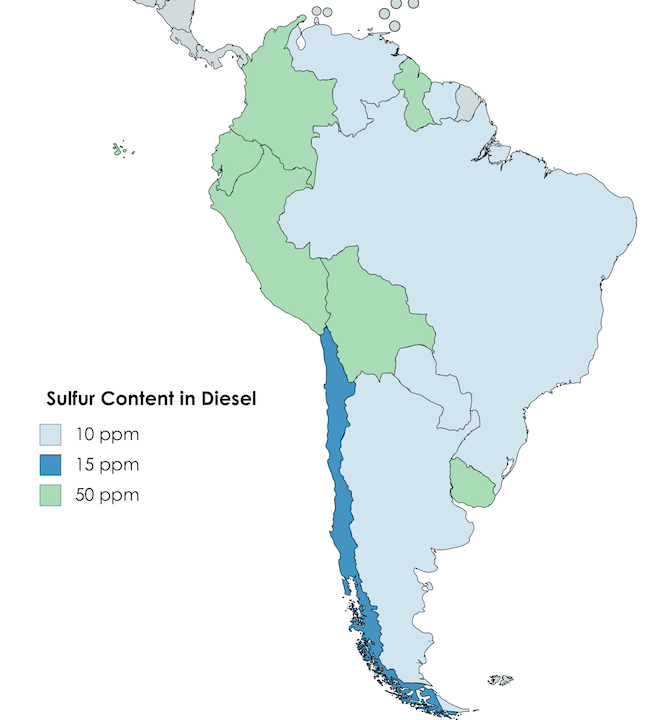
Molly runs on diesel. Diesel is the fuel source for the engine of the truck, our kitchen cooktop and the space/water heating system. Fortunately diesel is available throughout the world. However there is a small complication when traveling in less developed countries, including the countries of South America. The quality of the diesel available is not the greatest, and the lower quality causes complications for the truck engine.
Molly is an Euro V compliant diesel truck which means it can only run on Ultra Low Sulfur Diesel (ULSD), or diesel with 15 parts per million (ppm) sulfur content or lower. Many countries in South America do not have ULSD! This is what causes the complications.
The exhaust systems of Euro VI compliant trucks are somewhat complex, but they do a good job of protecting the environment by controlling the amount of particulate material (PM) and nitrogen oxides (NOx) that is emitted from the exhaust pipe. Other travellers have successfully driven throughout South America in Euro V/VI class vehicles, and the assumption is that we also be able to do the same. Also assumed is that we will be able to find enough of the “good diesel” to fill Molly’s fuel tanks. And when we can’t, then the hope is whatever diesel we do find, will not be too bad, and will not clog up or damage the filters and sensitive exhaust systems. Below is our current research on diesel sulfur levels and availability in various countries of South America.
USLD is not the only challenge in South America. The other three major travel considerations are 1) finding Diesel Exhaust Fluid (DEF), 2) working out how to purchase government subsidized fuel as a foreigner and 3) crossing borders with a right hand drive vehicle.
The best place we found with centralized information on driving in South America is from Wikioverland. Tucks Truck has been travelling extensively in South America and provides an excellent overview of the complexities involved. The above map is our best guess of the availability of ULSD in each country.
The following summary is compiled from Stratas Advisors, a company that seems to know what it is talking about:
- Peru expanded 50 ppm sulfur diesel into nine additional regions and plans to implement Euro 4/IV for all vehicle models in 2017.
- By the end of 2017, Ecuador and Peru plan to require 10-50 ppm sulfur fuels, although delays are expected again for them.
- Mexico plans to require 15 ppm sulfur diesel fuel by 2018 to meet Euro VI emission requirements.
- Paraguay is seeking to decrease max sulfur content in gasoline to 30 ppm by 2018.
- Brazil plans to require Euro VI emission standards by 2019.
- Mexico released draft specifications for bio-ethanol, bio-diesel and bio-jet.
- Argentina seeks to develop new specifications for E85 and E100.
- Ecuador postpones plan to implement E10 nationwide to 2019.
- Brazil commences three-year plan to move toward B10 bio-diesel blending, starting with B7 in March 2017.
Country by Country Information
Compiled on December 1, 2017
Argentina
According to wikipedia, cities with a certain population density need to offer grade 3 diesel fuel which is 10 ppm.
This is supported from this website that effectively states the same.
Grade 3 diesel fuel, also known as GASOIL ULTRA, is the highest quality diesel fuel, made available starting February 1, 2006. Sale of Grade 3 diesel at retail outlets was optional until 2008.
After the last reduction, in June 2016, the sulfur limits would become 1000 ppm, 30 ppm, and 10 ppm for the three respective grades.
Bolivia
Seems to be little useful information on the internet. Wikioverland states that diesel quality and sulfur content is high, but seems to contradict experiences from people who have been there. Advice from travelers seems to be the best approach.
overlanddiaries.com provides a good description of availability, bribes and experiences with sulfur content
tuckstruck.net states
“… can be summarised that diesel bought from non-YPFB fuel stations caused Cuthbert’s DPF to clagg-up at high altitude; whereas diesel from YPFB fuel stations (regardless of which of the two types of YPFB fuel station; the YPFB brand of diesel seems to be higher quality/lower sulphur than diesel from other fuel stations) caused fewer problems for the DPF at altitude.”
and
“Conclusion: the fuel in Bolivia from the YPFB station was of a comparable quality to that found in Chile and is not ‘poor quality’! Obviously this is only a single fill up from one station and I have not tried any other brands available in Bolivia. However, my assumption is that the fuel stations in the YPFB network all receive a similar quality of fuel, so YPFB would probably be a good choice for fuel in Bolivia if you are concerned about quality. As the fuel has a reasonable Cetane number, I would also advise against the use of any additives, especially if your vehicle has a DPF.”
Brazil
According to the Petrobra website, there is 15 ppm sulfur produced and traded in Brazil. It is not clear from their website how available it actually is. But wikipedia claims:
“Since January 2013 The 10 ppm or EURO V Diesel replaced the 50 ppm Diesel, which is now widely used and can be found in the majority of service stations”.
The above is also confirmed from this website.
“In December 2011, ANP Resolution 65/2011[2930] established new national requirements for diesel fuel and revoked ANP Resolutions 31/2009 and 42/2009. The new Resolution defined 4 grades of diesel fuel (S10, S50, S500 and S1800) and specified the phase-in requirements for different regions of the country. It also required the municipalities and fleets currently using A and B S50 to switch to A and B S10 starting January 1, 2013. It also required the replacement of B S1800 with B S500 starting January 1, 2014.”
Chile
According to the COPEC website, there is 15 ppm sulfur available in metropolitan areas, known as Ultra Diesel or Grade Oil A-1, The rest of the country is grade B. Grade B-1 is 15 ppm and grade B-2 is 50 ppm. See CPOEC website for more details.
This website indicates the emission standard for vehicles. It states:
“For medium-duty diesel fueled vehicles, these were be tightened to EPA Tier 2 Bin 5/Euro 5 in 2012.”
Colombia
Appears to have 50 ppm diesel. This is according to wikipedia and the following article wikipedia references. Trying to double-source this information. It seems that Euro 4 standard of 50 ppm is nationwide since 2013.
Ecuador
The refinery in Ecuador called Esmeraldas (110,000 bbl/d) is currently being upgraded to operate at full capacity and to produce low-sulfur diesel. The target date for less than 50 ppm is 2015.
French Guiana
The country has no refineries with fuel imported. No information found on this country.
Guyana
The country has no refineries with fuel imported. Based on this press release, at least one fuel station in Guyana has ULSD. This states
The Ultra-Low Sulfur Diesel contains only 0.0003% sulfur [30 ppm] and is beneficial in a number of ways.
Paraguay
Looks like from this notice (se below), 10 ppm in paraguay, Country is small enough not to worry.
“With final efforts to reduce the sulfur content in diesel, the MIC signed Decreto No. 4.562/15 on Dec. 11, 2015, establishing new specifications for diesel imported and sold on the national market in Paraguay. Starting March 1, 2016, two types of diesel are allowed to be imported and sold in the country, those being Type A/Type I with 10 ppm sulfur and Type C/Type III with 50 ppm sulfur. This decree maintains the import restrictions and previous modifications established in the Decretos No. 2.999/15 and 3.324/15, and ultimately abolishes the diesel specifications set forth in Resolucion 1336.”
Peru
This article suggests that Peru will have 50 ppm diesel nationwide.
“By January 1, 2010, sulfur in all diesel fuels is scheduled to have a maximum limit of 0.005% mass (50 ppm).”
This article seems to confirm the above. As does does this article which states
“In addition, the region of La Libertad will now be included amongst the current list of seventeen other regions where it is forbidden to market and use Diesel B5 with a sulphur content higher than 50 ppm. With the inclusion of this region, 93% of the country will have 50 ppm diesel and 27 million people will benefit from the positive effects of cleaner diesel.”
Suriname
Suriname has a refinery that produces ULSD according to this article.
“Fully commissioned during December 2015, the expansion has more than doubled the refinery’s crude capacity to 15,000 b/d from its previous 7,000 b/d to produce high-quality diesel and gasoline meeting the latest European quality standards, Staatsolie said.”
Staatsolie advertises that its fuel is 10 ppm
Uruguay
Looks like from this notice (see below) that Uruguay is moving to 50 ppm. Again, a small country, so probably not a problem for us.
“Since the last report, only two countries made advancements in sulfur reduction: Paraguay and Uruguay. In June 2014, Uruguay successfully switched to 30 ppm sulfur specifications for gasoline and 50 ppm sulfur for diesel.”
Country by Country Information Update
Compiled on July 19, 2020
Social media is a wonderful thing. Luis posted on the PanAmerican Travelers Association facebook page the following very useful update.
Peru. Diesel was 50 ppm in almost every department. Maybe if you go to Amazonas it you will find high sulfur diesel. Def was available. We drove over 4000 masl many times. We stayed here for 3 months.
Beautiful Chile is 15 ppm and def is available.
Working around the ULSD challenge
Although the quality of diesel in South America continues to improve each year, we have decided to make a modification to our truck making it easier to run on diesel with high sulfur content.
This change is to carry a second ECU which has been tuned to run on diesel with high sulfur content and a few other changes. This is all explained here.

